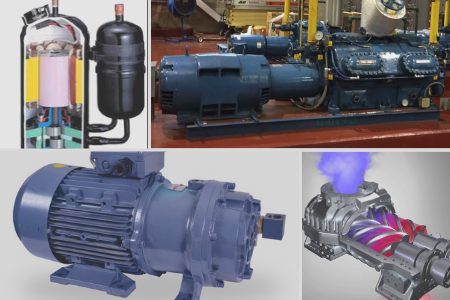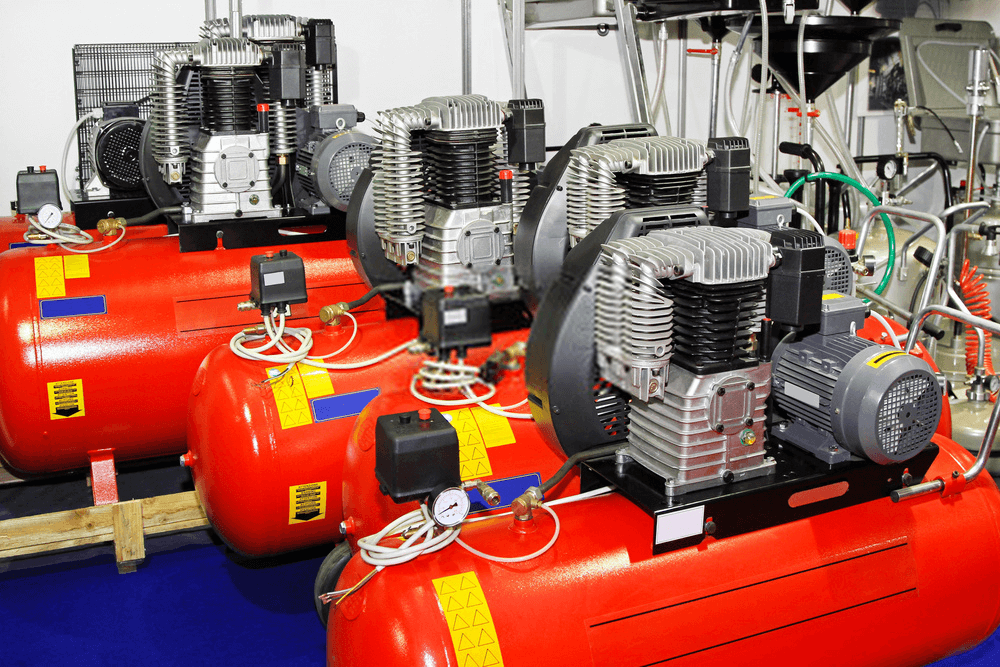It’s easy to get confused with different types of air compressors. But if you know how and what based on air compressors are categorized, it will be easier for you to understand the classification of air compressors.
Once you have been able to get an in-depth understanding of the compressor type, choosing the right one for your needs is a very simple task.
Here are the classifications of air compressors described below.
Different Types of Compressors:

All kinds of air compressors fall into primary two groups-either positive displacements or dynamic. Although they are either positive or dynamic displacement, you will find them with different models varying in pressure capacity.
The compressors with low air pressure capacity are designed for household tasks like inflating tires and small air tools such as staplers and nailers. The mediums are for professionals who use different kinds of air tools like impact wrench, paint sprayer, air sander, and air drill.
And the high-pressure compressors are for industrial use like automotive, aerospace, manufacturing fields, gas stations cars painting. Now let me tell you how both categories can be further classified and how each of them operates.
Let’s get started with positive displacement:
Positive Displacement Air Compressor
Positive displacement compressors are the most common type and have a wide range of applications. Here is how they work.
As the name suggests, a positive displacement system draws air from the atmosphere into the compression chamber through the displacement of moving parts. Then the volume of the chamber is reduced to compress the air which is thereafter discharged into the outlet system.
Now I am going to explain to you each type of air compressor which uses the positive replacement compression system.
Reciprocating Air Compressor
Reciprocating compressors, also known as piston compressors, are the oldest and most common version of positive displacement machines. They are energy efficient and are commonly used in almost every air project.
They employ pistons to increase the air pressure within a cylinder by reducing the volume. The pistons get a reciprocation motion, upper and lower, by the crankshaft run by either electric motor or internal combustion engines.
When the piston moves down, the inlet valve opens and lets the vapor come into the cylinder. This stage is called the suction stroke. When, on the other hand, the piston moves up, the inlet valve closes, and the outlet valve opens due to the reduction in the volume of the chamber to increase air pressure. The pressurized air then is discharged into the storage tank.
Piston compressors Types
However, the piston compressors come in two types – single acting and double acting.
Single Acting Compressors
When the reciprocating compressors employ only the one side of the piston to accomplish the air compression, it is considered as single-acting compressors.
Double Acting Air Compressors
The double-acting cylinder compressors, on the other hand, use both sides of the piston, which makes them more powerful and efficient than the single counterpart. While single acting reciprocating compressors are designed for home, automotive, and light industrial use with the range of 5-30 horsepower, the double-acting compressors are meant for heavy industrial applications with a high horsepower of 40 to over 1000HP.
Single Stage and Double Stage Air Compressors
Both can be found single-stage, double stage, and even multistage. Do you know what single stage or double stage means? Let me clear this. In a single-stage, the air is compressed one time only. The air is condensed twice in a double stage reciprocating compressor for further pressure.
I mean, the more the number of stages, the more times the air is condensed. Usually, the air is cooled between two stages using intercooler. However, Don’t be too concerned about how many stages a compressor uses. All that you need to focus on is how much pressure it can deliver to your air tools.
Rotary Screw Compressors
The rotary screw air compressors also apply the positive displacement technique. Unlike reciprocating compressors, rotary compressors employ two intermeshed helical screw rotors to compress air. As the rotors spin continuously, the air gets trapped between them and is compressed by forcing to relatively smaller space inside the housing.
They don’t use inlet and outlet valves. Instead, they position a slide valve, which opens itself when the compressor capacity is reduced, to bypass the pressurized air to the suction. These compressors are seen to be single stage, double stage, and multistage.
The working parts of these compressors never go extreme temperatures because of the internal cooling system. Oil is introduced at the airend as the coolant to absorb the heat, lubricate the moving parts, and seal the air pockets, leading to a lower operating temperature than centrifugal and reciprocating units. The oil is then separated from the air using an oil separator cartridge.
The rotary compressors have wide applications in the industry thanks to continual operation service with the high power, ranging from 25-250 horsepower. Even some modern versions reach up to 600 horsepower. They have excellent full load efficiency and can last 2-5 times longer.
Rotary Vane Compressors
Rotary vane compressors, also known as vane compressors, have been used for a long time in a wide variety of industries. They can provide superior energy with greater efficiency at a low cost. Rotary vane compressors apply a simple technique but very efficient. Instead of using the reciprocating motion of pistons, they employ centrifugal motion to obtain compressed air.
A vane compressor consists of a cylindrical offset rotor in a large housing and a set of vanes or blades. The rotor spins, the vanes slide in and out the housing with the contact of the cylinder wall. As a result, the air gets trapped between the blades at the larger opening and flows out at smaller, decreasing the volume and generating compressed air.
Although rotary vane compressors can run on both the electric motor and combustion engine, typically an electric motor is used to rotate the rotor directly. They can be single or multistage, can be portable or stationary, and can be oil-lubricated or oil-free. The choice is yours.
Compared to other types, these compressors consume less energy and can save up to 35% energy. They can have 90% mechanical efficiency with a longer lifespan.
Scroll compressor
Nowadays, scroll compressors are gaining in popularity in heating, ventilation, and air conditioning technology (HVAC) thanks to their excellent reliability and efficiency. As opposed to reciprocating compressors that use upward and downward movement of the piston, the scroll compressors work in a circular motion.
These are quieter than reciprocating type since they have only one moving part. Here is how they work. The scroll compressors exist of two spiral scrolls. While the one is fixed and attached to the main body, the other is moving through a swing link mechanism. The orbiting scroll rotates following a path defined by the stationary one.
When this happens, a series of pockets are created. The air is trapped into the pocket at the outer portion and transported to the center of the scrolls for the pockets are traveling between the scrolls. Again similar to reciprocating and rotary compressors, the air is compressed by reducing the volume.
What is the most significant advantage of these compressors is that they produce oil-free air as there is no need for oil use because of only one moving element. This leads to easy maintenance at a lower cost. As this simple technique doesn’t use pistons or vanes, it has been possible to achieve 100% volumetric efficiency.
That is why top manufacturers prefer the scroll compressor to meet their required efficiency level. Homeowners can also use this kind of compressor as they are available with single-stage and double stage. The single-stage is the simplest and cheapest version, which can operate at one speed only.
Home cooling and heating is the everyday use of the single-stage compressor. Double stage scroll air compressors can run at two speed, lower, and full speed. Although they are more energy-efficient, they tend to be costlier than the single stage.
There is also another sophisticated version called variable capacity compressors which can work at a wide range of operating speed instead of one or two settings.
Diaphragm compressors
Last but foremost important, diaphragm compressors, also known as membrane compressors, fall into the positive displacement group. This particular kind is a variant of reciprocating compressors, which is driven by an electric motor. It’s all about the sandwich diaphragm that causes air suction, compression, and discharge by its periodical elastic deformation in diaphragm air compressors.
Let’s have a close look at how these specially designed air compressors work.
Diaphragm compressor has two chambers, a hydraulic oil chamber and a gas chamber. As explained earlier how reciprocating mechanism works, the motor drives crankshaft to generate the reciprocating motion.
The crankshaft, in return, pushes and pulls the piston through the connecting rod. When the piston goes down, the hydraulic fluid goes back to the cylinder, causing a downward elastic deformation of the diaphragm. This increases the volume of the gas chamber. As a result, the inlet valve opens automatically, and the air gets sucked.
As opposed to downward movement, when the piston goes up, the hydraulic fluid causes an upward elastic deformation of the diaphragm, resulting in a reduction in the volume of the gas chamber.
As the volume reduces, the air in the chamber gets compressed. At a certain level of pressure, the outlet valve opens by itself, and the pressurized air is discharged to the storage tank.
When it comes to environmental protection, the diaphragm compressors are highly preferable and advantageous. Their application is very noticeable in food, pharmaceuticals, and nuclear industries.
This specific type is often considered for compressing flammable, radioactive, explosive, and toxic gases. The membrane condensers can be categorized into single-stage-multistage and vertical-horizontal.
Almost all positive displacement compressors available are explained above. Now, it’s time to talk about the dynamic type.
Dynamic Displacement Air Compressors
Unlike positive displacement that reduces the volume of the air chamber or air pockets physically to pressurize the vapor, the dynamic displacement speeds the airflow up rapidly and then constricts the air velocity, causing an increase in the pressure.
Let’s consider a situation for a better understanding. Imagine that the cars running on the interstate are air particles. When no traffic signals to stop, all the cars run faster as space is available.
When the red signal appears suddenly, all the cars stop, and the cars coming behind get slower and closer all together occupying the space, thus creating a jam. Similarly, the air molecules get pressurized by the dynamic system.
However, some external factors such as changes in the inlet valve temperature, low barometric pressure can have an impact on the capacity of dynamic compressors. They can be classified into axial and centrifugal, depending on their radial design.
Let me briefly discuss the centrifugal compressors.
Centrifugal Compressor
Centrifugal compressors are often called radial compressors as they use radial movements of air to create pressure. They primarily consist of three main parts, stationary casing, rotating impeller, and diffuser. What makes them unique is the ability to produce 100% oil-free air.
Centrifugal compressors convert the velocity and kinetic energy into pressure energy. They draw the atmospheric air into the center of a revolving element known as impeller by its radial vanes. Since the impeller rotates, the blades push the air outward from the center of the impeller.
Consequently, high pressure and kinetic energy are formed because of this radial movement of gas. This kinetic energy is then transmitted into pressure energy by passing through the diffuser.
They are also available with single-stage and multiple stages. Usually, the single-stage centrifugal compressor has one impeller which provides better efficiency than multistage. But multiple stages, which consist of 1-10 impellers, have more capacity than a single one. That’s why manufacturers and industrial prefer multiple stages to achieve high pressure. Every stage plays a role in raising the pressure to the desired level.
Axial compressors
Rather than creating a radial flow of the air, axial compressors, instead, generate axial movement of the gas to form compression. They consist of a series of rotating blades and a set of stationary blades, which are called rotors and stators, respectively. In axial compressors, the air enters and exits in the axial direction.
The airflow is accelerated by the rotors and the diffused by stators. The diffusion in stationary blades causes a high-pressure rise.
Axial compressors include a few stages, and every stage consists of a successive action of a pair of rotor-stator. Each stage takes part in increasing pressure while air passing from one stage to another. This is how multiple stages all together contribute to obtaining high pressure.
In comparison with their centrifugal equivalent, this specific type is smaller and lighter but faster in rotation speed. Axial compressors are inevitable where differential pressures and high flow are required. An ideal example of their application is in the jet engine. When coupled with gas turbines, they are suitable for generating electricity and propelling aircraft.
Whether it is positive displacement or dynamic, the output is compressed air. But every type has its distinct features, advantages, and disadvantages. So knowing this will enable you to determine which compressor is right for your project. And that’s what you are looking for. Isn’t this?

Olivia Archer provides in-depth coverage of air compressors, air compressor accessories, tire inflators and all things related to air compressors. She is a mechanical engineer and air compressor expert with a wealth of knowledge and experience in the industry.
Olivia’s articles are informative, well-researched and provide readers with valuable insights and information to help them make informed decisions when purchasing air compressors and accessories. She is passionate about the industry and is always looking for new ways to share her knowledge and expertise with readers. When she’s not writing for the website, Olivia can be found working on her own DIY projects, experimenting with different tools and techniques, and expanding her knowledge of the industry.


